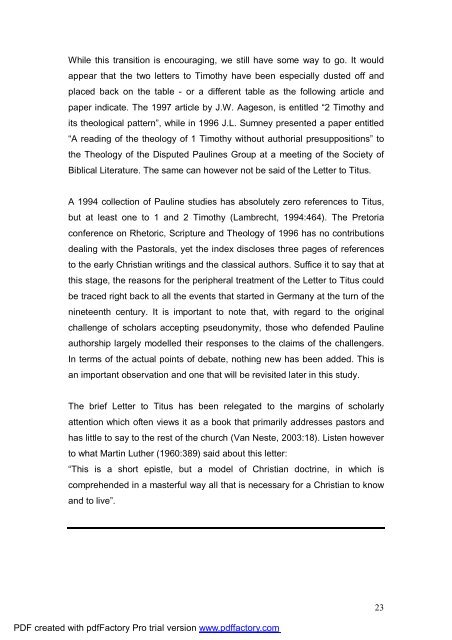A Text centred rhetorical analysis of Paul's Letter to Titus
A Text centred rhetorical analysis of Paul's Letter to Titus
A Text centred rhetorical analysis of Paul's Letter to Titus
You also want an ePaper? Increase the reach of your titles
YUMPU automatically turns print PDFs into web optimized ePapers that Google loves.
While this transition is encouraging, we still have some way <strong>to</strong> go. It would<br />
appear that the two letters <strong>to</strong> Timothy have been especially dusted <strong>of</strong>f and<br />
placed back on the table - or a different table as the following article and<br />
paper indicate. The 1997 article by J.W. Aageson, is entitled “2 Timothy and<br />
its theological pattern”, while in 1996 J.L. Sumney presented a paper entitled<br />
“A reading <strong>of</strong> the theology <strong>of</strong> 1 Timothy without authorial presuppositions” <strong>to</strong><br />
the Theology <strong>of</strong> the Disputed Paulines Group at a meeting <strong>of</strong> the Society <strong>of</strong><br />
Biblical Literature. The same can however not be said <strong>of</strong> the <strong>Letter</strong> <strong>to</strong> <strong>Titus</strong>.<br />
A 1994 collection <strong>of</strong> Pauline studies has absolutely zero references <strong>to</strong> <strong>Titus</strong>,<br />
but at least one <strong>to</strong> 1 and 2 Timothy (Lambrecht, 1994:464). The Pre<strong>to</strong>ria<br />
conference on Rhe<strong>to</strong>ric, Scripture and Theology <strong>of</strong> 1996 has no contributions<br />
dealing with the Pas<strong>to</strong>rals, yet the index discloses three pages <strong>of</strong> references<br />
<strong>to</strong> the early Christian writings and the classical authors. Suffice it <strong>to</strong> say that at<br />
this stage, the reasons for the peripheral treatment <strong>of</strong> the <strong>Letter</strong> <strong>to</strong> <strong>Titus</strong> could<br />
be traced right back <strong>to</strong> all the events that started in Germany at the turn <strong>of</strong> the<br />
nineteenth century. It is important <strong>to</strong> note that, with regard <strong>to</strong> the original<br />
challenge <strong>of</strong> scholars accepting pseudonymity, those who defended Pauline<br />
authorship largely modelled their responses <strong>to</strong> the claims <strong>of</strong> the challengers.<br />
In terms <strong>of</strong> the actual points <strong>of</strong> debate, nothing new has been added. This is<br />
an important observation and one that will be revisited later in this study.<br />
The brief <strong>Letter</strong> <strong>to</strong> <strong>Titus</strong> has been relegated <strong>to</strong> the margins <strong>of</strong> scholarly<br />
attention which <strong>of</strong>ten views it as a book that primarily addresses pas<strong>to</strong>rs and<br />
has little <strong>to</strong> say <strong>to</strong> the rest <strong>of</strong> the church (Van Neste, 2003:18). Listen however<br />
<strong>to</strong> what Martin Luther (1960:389) said about this letter:<br />
“This is a short epistle, but a model <strong>of</strong> Christian doctrine, in which is<br />
comprehended in a masterful way all that is necessary for a Christian <strong>to</strong> know<br />
and <strong>to</strong> live”.<br />
PDF created with pdfFac<strong>to</strong>ry Pro trial version www.pdffac<strong>to</strong>ry.com<br />
23

















